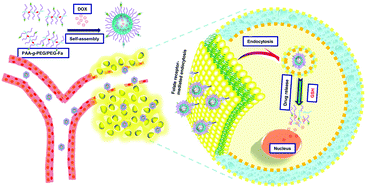DOX-encapsulated intelligent PAA-g-PEG/PEG–Fa polymeric micelles for intensifying antitumor therapeutic effect via active-targeted tumor accumulation†
Abstract
Stimuli-responsive targeted polymeric micelles as drug delivery systems have recently attracted significant attention for the treatment of various cancers, which could improve delivery efficiency by tumor-specific recognition via active targeting strategies. In this research, DOX-incorporated bioreducible polymeric micelles based on PAA-g-PEG/PEG–Fa conjugated polymers were prepared and characterized as nanocarriers for promoting intracellular anti-tumor drug delivery efficiency via folate receptor-mediated endocytosis. The anti-proliferative activity on cancer cells, biodistribution, active-/passive-targeting efficiency, tumor growth inhibition efficiency, and biological toxicity were evaluated in vitro and in vivo. The MTT assay demonstrated that the DOX-encapsulated active-targeting PAA-g-PEG/PEG–Fa micelles had much greater growth inhibition effect against 4T1 and KB than passive-targeting micelles. These active-targeting micelles showed superior tumor accumulation and excellent tumor growth inhibition effect as revealed by the fluorescence optical imaging technique and tumor volume change investigation, as well as the survival study of the tumor-bearing Balb/c mice. Furthermore, the active targeting micelles greatly decreased the toxicity of DOX on the heart and other organs. These potential results encouraged us to further optimize the molecular structure to achieve more excellent targeted therapeutic effect.


 Please wait while we load your content...
Please wait while we load your content...